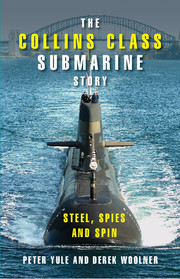Book contents
- Frontmatter
- Contents
- List of key people
- List of acronyms
- Introduction
- Part 1 You Can't Build Submarines in Australia
- Part 2 The Honeymoon Years 1987–92
- 11 ‘Keen as mustard to do a good job’: setting to work 1987–89
- 12 Designing the Collins class
- 13 Building submarines
- 14 The automated integrated vision
- 15 Steel, sonars and tiles: early technological support for the submarines
- 16 ‘On time and on budget’
- Part 3 ‘A Strange Sense of Unease” 1993–98
- Part 4 Resolution
- Notes
- Index
11 - ‘Keen as mustard to do a good job’: setting to work 1987–89
Published online by Cambridge University Press: 05 September 2013
- Frontmatter
- Contents
- List of key people
- List of acronyms
- Introduction
- Part 1 You Can't Build Submarines in Australia
- Part 2 The Honeymoon Years 1987–92
- 11 ‘Keen as mustard to do a good job’: setting to work 1987–89
- 12 Designing the Collins class
- 13 Building submarines
- 14 The automated integrated vision
- 15 Steel, sonars and tiles: early technological support for the submarines
- 16 ‘On time and on budget’
- Part 3 ‘A Strange Sense of Unease” 1993–98
- Part 4 Resolution
- Notes
- Index
Summary
The contract between the Commonwealth and the Australian Submarine Corporation was signed on 3 June 1987. Several days later two members of the ASC team, Graeme Ching and Ross Milton, were at Sydney airport and Milton remembers his companion saying to him while watching the throng of business people: ‘I don't know what any of them are doing, but I know it's not a patch on what we've just done – sign a contract for $2.9 billion.’
Intense negotiations had continued until the night before the contract was signed, and the ASC team were all exhausted. As Pelle Stenberg recalls: ‘Everyone was dead beat - but the real work had to start.’
Their focus had been entirely on winning the contract. While the project definition study and the evaluation process had established much of the framework for beginning the next phase, few of those involved appreciated the enormity of the project. To some extent this is not surprising as it was a project without precedent in Australia – it was the country's largest military contract and it aimed to achieve the highest proportion of Australian industry involvement of any major project, while at the same time having the most multinational flavour, with the prime contractor having joint Swedish, American and Australian ownership and sub-contractors coming from many countries.
- Type
- Chapter
- Information
- The Collins Class Submarine StorySteel, Spies and Spin, pp. 119 - 129Publisher: Cambridge University PressPrint publication year: 2008



